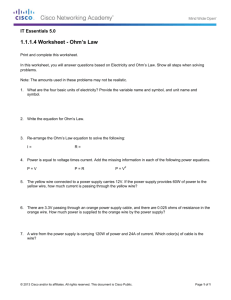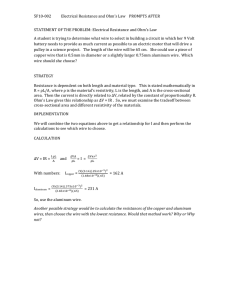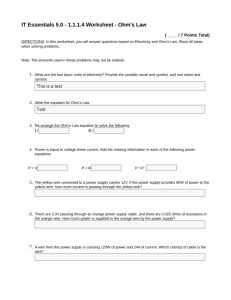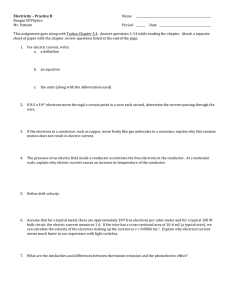Ohm`s Law - Brown University Wiki
advertisement
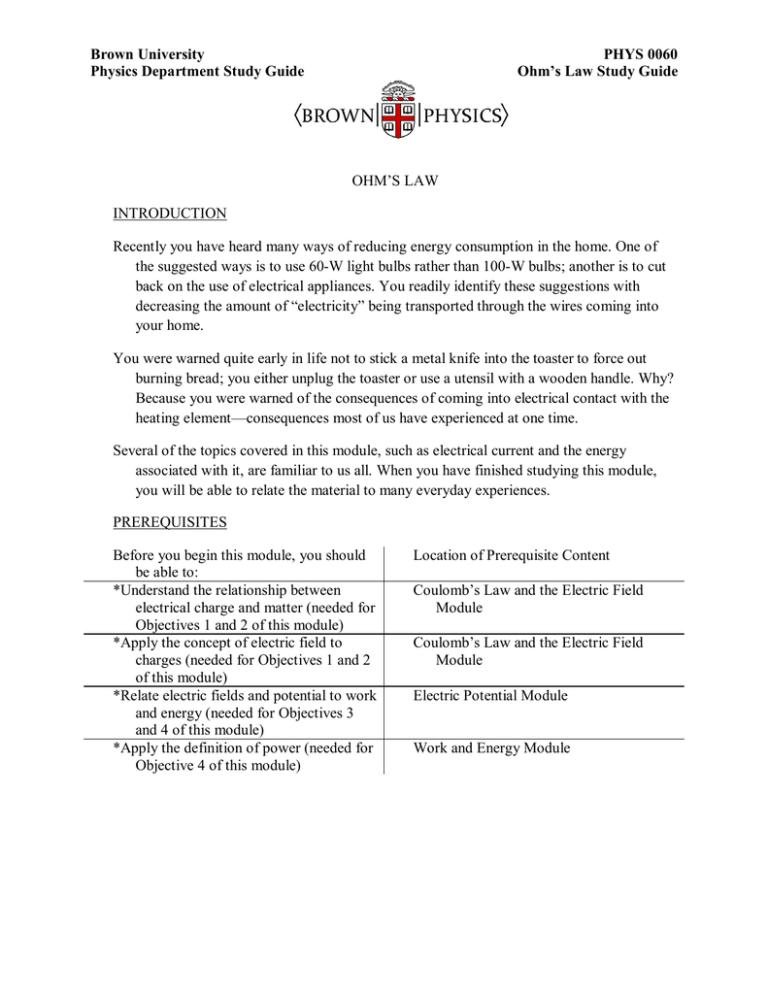
Brown University Physics Department Study Guide PHYS 0060 Ohm’s Law Study Guide OHM’S LAW INTRODUCTION Recently you have heard many ways of reducing energy consumption in the home. One of the suggested ways is to use 60-W light bulbs rather than 100-W bulbs; another is to cut back on the use of electrical appliances. You readily identify these suggestions with decreasing the amount of “electricity” being transported through the wires coming into your home. You were warned quite early in life not to stick a metal knife into the toaster to force out burning bread; you either unplug the toaster or use a utensil with a wooden handle. Why? Because you were warned of the consequences of coming into electrical contact with the heating element—consequences most of us have experienced at one time. Several of the topics covered in this module, such as electrical current and the energy associated with it, are familiar to us all. When you have finished studying this module, you will be able to relate the material to many everyday experiences. PREREQUISITES Before you begin this module, you should be able to: *Understand the relationship between electrical charge and matter (needed for Objectives 1 and 2 of this module) *Apply the concept of electric field to charges (needed for Objectives 1 and 2 of this module) *Relate electric fields and potential to work and energy (needed for Objectives 3 and 4 of this module) *Apply the definition of power (needed for Objective 4 of this module) Location of Prerequisite Content Coulomb’s Law and the Electric Field Module Coulomb’s Law and the Electric Field Module Electric Potential Module Work and Energy Module Brown University Physics Department Study Guide PHYS 0060 Ohm’s Law Study Guide LEARNING OBJECTIVES After you have mastered the content of this module, you will be able to: 1. Current—Apply the definition of current or current density to problems in conductors in which these are related to electric charge 2. Drift Speed—Apply the microscopic model for conduction in a metal to problems where you are given information concerning several of the quantities (drift speed, current, current density, charge, charge density, cross-sectional area) and are asked to solve for another. 3. Ohm’s Law—Solve problems using the relationships among resistance, potential difference, electric current, current density, electric field, resistivity, and the physical dimensions of a conductor. 4. Electric Power—Apply the relation for instantaneous power (P = IV) to problems dealing with resistive elements obeying Ohm’s law. 2 Brown University Physics Department Study Guide PHYS 0060 Ohm’s Law Study Guide GENERAL COMMENTS 1. Vector Notation—Current Most physicists prefer not to treat current as a vector. A convention for labeling current is needed because charges of opposite sign move in opposite directions in an electric field. Hence for simplicity of treatment you may treat all charge carriers as positive and draw arrows (not representative of vectors) in the direction that these charges would move. This is usually termed conventional current (the direction that positive charges would move in a wire). (For currents in wires, a negative charge moving in one direction is equivalent to a positive charge moving in the opposite direction. See Problem A.) Current density is a vector that at any given point in the conductor has a direction determined by the velocity vector of a positive charge moving through that point. The current is the same everywhere along a wire. This follows from conservation of charge, i.e., electrons just do not appear/disappear along the wire. This is a very simple but very important concept and will be used in problem solving in the module Direct Current Circuits. 2. Thermal Speed We would like to stress that average thermal speed of the random moving electrons is on the order of 108 times larger than the drift speed of these electrons. Even though the drift speed is surprisingly small, a change in the force that produced this motion can propagate through the conductor at nearly the speed of light (3.00 x 108 m/s). This is why, when you turn on the light switch, the light goes on “instantaneously”. The speed of the electrons in a conductor subjected to a potential difference is very small. Even though the electrons in a metal have such small drift speed, the phenomenon responsible for it—the electric field—travels along the wire at nearly the speed of light. 3. Ohm’s Law It should be stressed that only when the resistance R is constant is the expression V = IR called Ohm’s Law. In a current-voltage (IV) plot as in Figure 1, the resistance for a given value of voltage and current is the reciprocal of the tangent of the curve at that point, and if R is independent of current and voltage, then the curve is straight line. Ohm’s law is sometimes stated in terms of microscopic quantities, where the resistivity is assumed constant. Ohm’s law follows from the definition of resistance when the resistance is independent of current and voltage. In this module we confine our discussion to homogenous conductors and electrostatic fields. I V Figure 1 3 Brown University Physics Department Study Guide PHYS 0060 Ohm’s Law Study Guide PROBLEM SET WITH SOLUTIONS A (1) A current (Fig. 2) is established in a gas-discharge tube when a sufficiently high potential difference is applied across the two electrodes in the tube. The gas ionizes; electrons move toward the positive terminal and positive ions toward a negative terminal. What are the magnitude and sense of the current in a hydrogen-discharge tube in which 3.1x1018 electrons and 1.1x1018 protons move past a cross-sectional area of the tube each second? Solution The number of electrons passing cross-sectional area AA in 1.00 s is 3.10x1018, and since the charge on an electron is -1.60x10-12C, the negative charge crossing AA to the left per second is 𝐼− = (3.10𝑥1018 𝑒𝑙𝑒𝑐𝑡𝑟𝑜𝑛𝑠/𝑠)(−1.60𝑥10−19 𝐶/𝑒𝑙𝑒𝑐𝑡𝑟𝑜𝑛) = −5.0𝑥10^ − 1 𝐴 The number of protons crossing AA per second is 1.10x1018, and since the charge on the proton is +1.60x10-19 C, the positive charge crossing AA to the right per second is 𝐼+ = (1.10𝑥1018 𝑝𝑟𝑜𝑡𝑜𝑛𝑠/𝑠)(1.60𝑥10−19 𝐶/𝑒𝑙𝑒𝑐𝑡𝑟𝑜𝑛) = −5.0𝑥10−1 𝐴 The negative charge moving to the left is equivalent to positive charge moving to right, thus 𝐼𝑡𝑜𝑡𝑎𝑙 = |𝐼− | + |𝐼+ | = 6.8𝑥10−1 𝐴 to the right A + + + + + + - + A - Figure 2 4 Brown University Physics Department Study Guide PHYS 0060 Ohm’s Law Study Guide B(1) The current in a wire varies with time according to the relation 𝐼 = 20 sin 120𝜋𝑡 , where I is in amperes, t is in seconds, 120πt in radians, and the constants are 20 A and 120/s. a. How many net coulombs of charge pass a cross section of the wire in the time interval between t = 0 and t = 1/60 s? b. In the interval between t = 0 and t = 1/120 s? c. What constant current would transport the same charge in each of the intervals above? Solution a. From the definition of current 𝐼 = 1 𝑠 60 𝑑𝑄 𝑑𝑡 or𝑑𝑄 = 𝐼 𝑑𝑡 , thus 1 20 𝑠 60 [cos(120𝜋𝑡)]|0 𝑄 = � 𝐼𝑑𝑡 = � 20 sin 120𝜋𝑡 = − 120 𝑡𝑖 0 1 1 = − � 𝜋� (cos 2𝜋 − cos 0) = − � 𝜋� (1 − 1) = 0 6 6 A plot of current versus time would look like Figure 3. Therefore t=0, I=0; it increases to 20A at t=1/240 s and decreases to zero at t = 1/120 s. Now the current changes direction and increases to 20 A at t = 1/80 s in the opposite direction. One can therefore see that as much charge flowed to the left through the cross section during the next 1/120 s. Thus the net charge passing the cross section 1/60 s is 0. 𝑡𝑓 1 𝑠 20 1 2 1 b. 𝑄 = ∫0120 20 sin 120𝜋𝑡 = − 120𝜋 (cos 𝜋 − cos 0) = − 6𝜋 (−1 − 1) = 6𝜋 = 3𝜋 = 0.106 𝐶 c. For a constant current 𝐼 = 𝑄/𝑡. For 1/60 s, Q = 0, so I = 0. For 1/120 s, Q = 0.106 C, so 1 𝐶 40 3𝜋 𝐼= = 𝐴 = 12.7 𝐴 1 𝜋 𝑠 120 I (amperes) 20 -20 1 240 1 120 1 80 1 60 t(s) wire Figure 3 5 Brown University Physics Department Study Guide PHYS 0060 Ohm’s Law Study Guide C(2) A small but measurable current of 1.00x10-10 A exists in a copper wire whose diameter is 0.250 cm. Calculate the electron drift speed. Solution 𝐽 = 𝑛𝑒𝑣𝑑 , Current density =(charge per unit volume)(electronic charge)(drift speed), 𝑣𝑑 = 𝐽 𝑛𝑒 . N 0 is Avogadro’s number, d is mass density, e f is free electrons, and M is atomic weight: 𝑘𝑔 𝑎𝑡𝑜𝑚𝑠 𝑒𝑙𝑒𝑐𝑡𝑟𝑜𝑛 �6.0𝑥1026 𝑘𝑔 𝑚𝑜𝑙 � �9.0𝑥103 3 � �1 𝑎𝑡𝑜𝑚 � 𝑚 = 𝑛= 𝑀 64 = 8.4𝑥1028 𝑒𝑙𝑒𝑐𝑡𝑟𝑜𝑛𝑠/𝑚3 𝐼 1.00𝑥10−10 𝐴 𝐽= = = 2.00𝑥10−5 𝐴/𝑚2 , 𝑎𝑟𝑒𝑎 0.250 2 𝜋� � 2𝑥102 𝑚 𝐽 2.00𝑥10−5 𝐴/𝑚2 𝑣𝑑 = = = 1.48𝑥10−15 𝑚/𝑠 𝑛𝑒 (8.4𝑥1028 𝑒𝑙𝑒𝑐𝑡𝑟𝑜𝑛𝑠/𝑚3 )(1.60𝑥10−19 𝐶/𝑒𝑙𝑒𝑐𝑡𝑟𝑜𝑛) 𝑒𝑓 𝑁0 𝑑 �𝑎𝑡𝑜𝑚� D(2) A typical copper wire might have 2.00x1021free electrons in 1.00 cm of its length. Suppose the drift speed of the electrons along the wire is 0.050 cm/s. a. How many electrons would pass through a given cross section of wire each second? b. How large a current would be flowing in the wire? Solution a. n Av d = (electrons/volume)(cross-sectional area)(length/second) = [electrons/(length)(area)](area)(length/second) = number of electrons crossing a cross-sectional area in one second = (electrons/length)(length/second) =[(2.00x1021electrons)/(1.00 cm)] 5.0x10-2 cm/s = 1.00x1020 electron/s. b. e = 1.60x10-19 C/electron I = (1.60x10-19 C/electron)(1.00x1020 electron/s) = 16.0 A 6 Brown University Physics Department Study Guide PHYS 0060 Ohm’s Law Study Guide E(3) A copper wire and an iron wire of the same length have the same potential difference applied to them. See Figure 4. a. What must be the ratio of their radii if the current is to be the same? b. Can the current density be made the same by suitable choices of the radii? Take 𝜌𝐶𝑢 = 1.70𝑥10−8 Ω 𝑚, 𝜌𝐹𝑒 = 1.00𝑥10−7 Ω 𝑚. Solution a. V AB = potential difference A and B. Ohm’s law, V = IR : 𝐼𝜌𝑙 𝐼𝜌𝑙 𝑉= = 2. 𝐴 𝜋𝑟 (𝑉𝐴𝐵 )𝐶𝑢 (𝑉𝐴𝐵 )𝐹𝑒 = 2 𝐼𝐶𝑢 𝜌𝐶𝑢 𝑙𝐶𝑢 /𝜋𝑟𝐶𝑢 2 𝐼𝐹𝑒 𝜌𝐹𝑒 𝑙𝐹𝑒 /𝜋𝑟𝐹𝑒 where l Cu = l Fe , (V AB ) Cu = (V AB ) Fe , I Cu = I Fe 1 2 2 𝜌𝐶𝑢 /𝑟𝐶𝑢 𝑟𝐹𝑒 𝜌𝐹𝑒 𝑟𝐹𝑒 1.00𝑥10−7 2 � � = 2.43 𝑙= 𝑜𝑟 = 𝑜𝑟 = 2 2 𝜌𝐶𝑢 𝑟𝐶𝑢 1.70𝑥10−8 𝜌𝐹𝑒 /𝑟𝐹𝑒 𝑟𝐶𝑢 b. From above, 1 = 2 𝐼𝐶𝑢 𝜌𝐶𝑢 𝑟𝐹𝑒 2 𝐼𝐹𝑒 𝜌𝐹𝑒 𝑟𝐶𝑢 . Therefore 2 2 𝐼𝐹𝑒 𝜌𝐹𝑒 𝑟𝐹𝑒 = 𝐼𝐶𝑢 𝜌𝐶𝑢 𝑟𝐶𝑢 𝑜𝑟 𝐼𝐹𝑒 𝜌𝐹𝑒 𝐼𝐶𝑢 𝜌𝐶𝑢 = 2 2 𝑟𝐹𝑒 𝑟𝐶𝑢 2 Multiplying both sides by 1/π and nothing that 𝜋𝑟𝐹𝑒 = (area) Fe and IFe /(area) Fe = J Fe , we have J Fe ρ Fe = J Cu ρ Cu or J Fe /J Cu = ρ Cu /ρ Fe B A Cu Fe Fe 2.0 m T 3.0 m Figure 5 l Figure 4 7 Brown University Physics Department Study Guide PHYS 0060 Ohm’s Law Study Guide If J Fe = J Cu , then ρ Fe = ρ Cu . Since this is impossible, J Fe ≠ J Cu . A shorter argument might be given by using the relation E = ρJ. Since E = V/l is the same for both wires, J must be different for different values of ρ. F(3) An iron wire of 1.00 m diameter and 2.00 m length is connected to a tungsten wire of 1.00 Ω resistance and 3.00 m length. A potential difference of 60 V is applied to the combined wire 5.0 in length. The resistivity of iron is 1.00x10-7Ωm. a. What is the current flowing in the iron wire? In the tungsten wire? b. What is the electric field in the iron wire? Solution a. See Figure 5. 𝑙 𝐹𝑒 𝑅𝐹𝑒 = 𝜌𝐹𝑒 (𝑎𝑟𝑒𝑎) 𝐹𝑒 = �1.00𝑥10−7Ω𝑚�(2.00𝑚) 𝜋(5.0𝑥10−4 𝑚)2 𝑉 𝑅𝑡𝑜𝑡𝑎𝑙 = 𝑅𝑓𝑒 + 𝑅𝑇 = 1.20 Ω , 𝐼 = b. 𝐸 = 𝜌𝐽 = 6.1 𝑉 𝑚 𝑅 = 0.254 Ω = (60 𝑉 )(1.20 Ω) = 50 𝐴 in both wires G(4) Consumers of electric energy pay by the kilowatt-hour. What is the cost of operating a 10.0Ω toaster across a potential difference of 110 V for 20 min at the rate of 3.00 cents per kilowatt-hour? Solution Power = (current)(potential difference) = P = (I)(V) = V2/R where I = V/R from Ohm’s law. P = (110 V)2/ (10.0 Ω) = 1210 W = 1.21 kW Work = Pt = (1.21 kW)(20/60 h) = 0.40 kWh $ = (0.40 kWh)(0.030 dollar/kWh) = $0.012 = 1.20 cent(s) H(4) 8 Brown University Physics Department Study Guide PHYS 0060 Ohm’s Law Study Guide A clever student decides to defrost the windshield of her sports car by covering it with a transparent conductive coating. The coating is 1.40 m long, 0.30 m wide, and 5.0x10-4 m thick and has a resistivity of 7.0x10-5 Ω-m. If the “defroster” is to be operated from the 12.0-V system of the car: a. What is the power dissipated by the defroster? b. How much current does the defroster utilize? Solution 𝑅= 𝜌𝑙 𝐴 = 0.65𝛺 . Assuming the defroster obeys Ohm’s Law a. 𝑃 = 𝑉2 𝑅 = 220 𝑊, where V = 12.0 V b. I = V/R = 18 A Problems I(1) The total charge that has passed a given cross section varies with time according to the relation 𝑡 𝑄(𝑡) = 𝐾 �1 − 𝑒 −𝐵 � , where K = 3.00x10-5 C and B = 1.00 s. a. Determine the current in the wire as a function of t. b. If the cross-sectional area of the wire is uniform and is 3.00x10-5 m2, what is the current density in the wire as a function of t? c. When t = 1.00 s, how does the current compare to that at t = 0 s? d. Draw a rough sketch of I versus t. J(2) A 10.0-m length of Number-18 copper wire is carrying a current of 5.0 A. If the diameter of the wire were doubled, with the same current, how would the drift speed change? Support your conclusion with a short physical argument. K(3) Number-10 copper wire can carry a maximum current of about 30 A before overheating. Its diameter is 0.260 cm. The resistivity of copper is 1.70x10-8 Ω m. a. Find the resistance of a 1.00-m length of the wire. 9 Brown University Physics Department Study Guide PHYS 0060 Ohm’s Law Study Guide b. How large a voltage drop occurs along it per meter when it carries a current of 30.0 A. L(4) You decide to heat your office by placing a steel plate (resistivity = 1.80x10-7 Ω m) under the rug and passing a current through it from one side to the other. If the room is 4.0 m square and you want to get 4.0 kWatts by connecting it to a 120-V power line, how thick should the plate be? Assume the current is distributed uniformly in the plate. 4m 4m Solutions I(1) 𝐾 𝑡 1 𝑡 a. 𝐼 = � � 𝑒 −𝐵 𝐵 Figure 6 b. 𝐽 = � � 𝑒 −𝐵 c. 𝐵 𝐼(𝑡=1.00𝑠) 𝐼(𝑡=0𝑠) = 0.37 d. See Figure 7 for I versus t. J(2) Decreases to ¼; 𝐽 = K/B 𝐼 𝐴 = 𝑛𝑒𝑣𝑑 . 𝐴 = 𝜋𝑑 2 /4; I and ne are constant. See how vd changes when A changes K(3) a. 3.20x10-3Ω b. 0.096 V K/2B 1 2 3 t(s) Figure 7 L(4) Assuming Ohm’s Law; thickness = 5.0x10-8 m 10


